Welcome to the world of Cat Clicker Training! If you’re looking for an effective and enjoyable way to train your feline friend, you’ve come to the right place. In this article, we will share expert techniques that will help you master the art of Cat Clicker Training. But first, let’s understand what Cat Clicker Training is and how it works.
Key Takeaways:
- Cat Clicker Training is a proven method for teaching cats using positive reinforcement.
- It involves associating a clicking sound with a reward to communicate desired behaviors to your cat.
- Clicker training can be used to teach various tricks and tasks, as well as address behavioral issues.
- Choosing the right clicker and creating a positive training environment are crucial for successful training sessions.
- Consistency and patience are key when training your cat with a clicker.
Now that you have an idea of what Cat Clicker Training is all about, let’s dive deeper into the topic. In the next section, we will explore the fundamentals of Cat Clicker Training and how understanding its principles can benefit you and your cat.
Understanding Cat Clicker Training
Welcome to the world of cat clicker training! In this section, we will explore the basics of cat clicker training and provide insights into how this method works. By understanding the fundamentals, you’ll be well-prepared to embark on your cat’s training journey using a clicker.
What is Cat Clicker Training?
Cat clicker training is a positive reinforcement-based training technique that uses a clicker as a marker for desired behaviors. The clicker is a small handheld device that produces a distinct clicking sound when pressed. It serves as a clear communication tool, signaling to your cat that they have done something correctly or earned a reward.
The foundation of clicker training lies in the principle of associating the clicker sound with positive reinforcement, such as treats or praises. Through repetition and consistency, your cat learns to associate the clicker with a reward, making it an effective tool for shaping desired behaviors.
How Does Cat Clicker Training Work?
When engaging in cat clicker training, you’ll begin by introducing your cat to the clicker and helping them understand that the sound indicates something good is coming. This initial step is known as “charging the clicker.”
Once your cat associates the clicker sound with positive reinforcement, you can start using it to reinforce specific behaviors. For example, if you’re teaching your cat to sit, you would click the moment they perform the desired action and follow it with a treat or praise.
The clicker acts as a precise and instant way of favorably marking the exact moment your cat exhibits the desired behavior. This clarity enhances communication and helps your cat understand the specific behavior that earns them a reward.
With cat clicker training, the focus is on positive reinforcement and reward-based learning. It cultivates a bond of trust and cooperation between you and your cat, making training sessions enjoyable and effective.
In the next section, we will guide you in choosing the best clicker for your cat’s training needs. Stay tuned to discover the different options available and how to select the most suitable one.
Choosing the Best Clicker for Cat Training
When it comes to cat training, one tool that has proven to be highly effective is a clicker. A clicker is a small handheld device that produces a distinct clicking sound when pressed. This sound serves as a signal to your cat, indicating that they have performed the desired behavior correctly. But with so many clickers available in the market, how do you choose the best one for your cat?
First and foremost, consider the type of clicker that would work best for your training sessions. There are two main types of clickers: box clickers and button clickers. Box clickers require a bit more force to produce the click sound, while button clickers are more sensitive and can be operated with a gentle touch. Depending on your cat’s sensitivity and your personal preference, choose the one that feels comfortable for you to use.
Another factor to consider is the clicker’s durability. Look for clickers that are made of sturdy materials and can withstand accidental drops or rough handling. Opt for clickers with solid construction that will last for a long time, ensuring you can use them for continuous training sessions without worrying about them breaking.
In addition to durability, clickers with a comfortable grip are also beneficial. Since cat training can involve repetitive actions, it’s important to choose a clicker that feels ergonomic in your hand, reducing any strain or discomfort during training.
Lastly, some clickers come with additional features such as adjustable volume or a wrist strap. These features can enhance your training experience by allowing you to customize the volume of the click sound or keep the clicker securely attached to your wrist, ensuring you don’t misplace it during training sessions. Consider these extra features based on your preferences and needs.
- Consider the type of clicker that suits your training style, selecting between box clickers and button clickers.
- Choose a clicker with a durable and sturdy construction to withstand regular use.
- Opt for a clicker with a comfortable grip to ensure a comfortable training experience.
- Consider additional features like adjustable volume or a wrist strap for added convenience.
By selecting the best clicker for your cat’s training needs, you will set the foundation for successful and rewarding training sessions. So take your time, explore the options, and choose a clicker that both you and your feline friend will enjoy using.
How to Train Your Cat with a Clicker
Training your cat with a clicker is an effective and rewarding method that can strengthen the bond between you and your feline companion. By following these step-by-step instructions, you’ll be able to teach your cat new behaviors and commands using positive reinforcement.
Step 1: Familiarize Your Cat with the Clicker
Start by introducing your cat to the clicker. Press the clicker and immediately give them a treat. Repeat this process multiple times for a few days until your cat associates the sound of the clicker with a reward. This step is crucial as it establishes the clicker as a positive marker for good behavior.
Step 2: Define the Desired Behavior
Decide on the behavior or command you want to train your cat to do. Keep it simple and gradually increase the complexity as your cat progresses. For example, if you want to teach your cat to sit, wait for them to naturally assume the sitting position and immediately click the clicker. Follow it up with a treat to reinforce the behavior.
Step 3: Click and Reward
When your cat exhibits the desired behavior, click the clicker at the exact moment they perform it. This precise timing helps your cat understand which specific action is being rewarded. After clicking, offer your cat a treat as positive reinforcement. Repeat this process consistently to reinforce the behavior you’re training.
Step 4: Shape and Capture Behaviors
Cats learn through small steps, so be patient and break down the desired behavior into smaller achievable actions. Gradually shape their behavior by clicking and rewarding incremental progress. For example, if you want your cat to jump through a hoop, start by rewarding them for approaching the hoop, then for touching it, and finally for jumping through it.
Step 5: Keep Training Sessions Short and Positive
Short, frequent training sessions work best for cats. Aim for about 5-10 minutes per session, once or twice a day. Cats have short attention spans, so keeping the sessions brief prevents them from getting bored or overwhelmed. Always end each session on a positive note, rewarding your cat for their effort.
Clicker Training Tips for Cats
Are you ready to take your cat’s clicker training to the next level? Here are some valuable tips and tricks that will enhance your cat’s clicker training experience. From creating a positive training environment to handling challenges, we’ve got you covered.
Create a Positive Training Environment
Setting the right environment is crucial for successful clicker training. Choose a quiet and distraction-free space where your cat can focus on the training session. Make sure the room is well-lit and comfortable for both you and your feline friend.
Provide enticing treats or rewards that motivate your cat during training. Use high-value treats that your cat loves, such as small pieces of cooked chicken or tuna. This will help create a positive association with the clicker and training sessions.
Be Consistent and Frequent
Consistency is key when it comes to clicker training. Set aside regular training sessions with your cat to reinforce the learned behavior. Keep the sessions short and frequent to maintain your cat’s interest and prevent boredom or frustration.
Remember to use the clicker and treat immediately after your cat performs the desired behavior. Consistently timing the click and reward will help your cat understand which behavior is being rewarded, allowing for quicker learning.
Start with Simple Commands
Begin with basic commands when introducing your cat to clicker training. Start with simple behaviors such as sitting or touching a target stick. These commands are easy for cats to understand and can build a foundation for more advanced training later on.
Break down complex commands into small steps and reward each successful step along the way. This gradual approach will prevent your cat from getting overwhelmed and increase their chances of success.
Handle Challenges with Patience
Clicker training may come with its fair share of challenges, but patience is key. If your cat seems disinterested or unresponsive, take a step back and assess the situation. It might be helpful to revisit basic commands or adjust the training environment to increase motivation.
If your cat makes a mistake or doesn’t perform the desired behavior, avoid punishment or scolding. Instead, simply withhold the click and reward. This way, your cat will learn from their mistakes without associating any negative experiences with the training process.
Continue to Advance Your Training
As your cat progresses in their clicker training journey, continue to challenge them with more advanced commands and behaviors. Gradually introduce new tricks or complex behaviors that require increased focus and coordination.
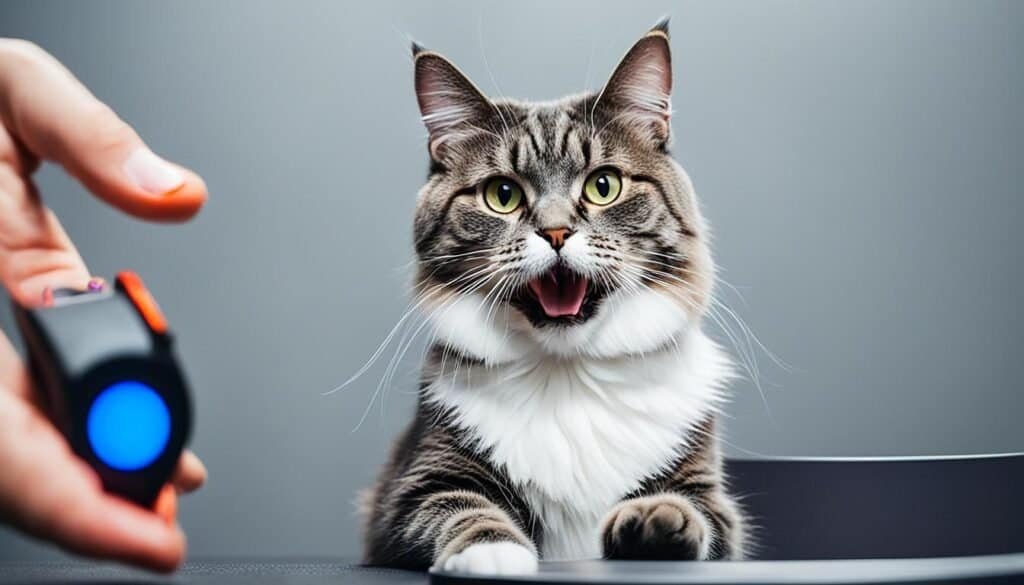
Remember, clicker training is a rewarding experience for both you and your cat. Embrace each training session as an opportunity to bond with your feline friend while encouraging mental stimulation and physical activity.
Cat Behavior Clicker Training
Dive deeper into the connection between cat behavior and clicker training. Discover how you can use clicker training to address specific behavioral issues and reshape your cat’s behavior.
Cats, like humans, exhibit a wide range of behaviors that can sometimes be challenging to manage. Whether it’s excessive meowing, scratching furniture, or aggression towards other pets, addressing these issues requires a targeted approach. This is where cat behavior clicker training comes in.
The Power of Clicker Training for Behavior Modification
Clicker training uses positive reinforcement to shape desired behaviors in cats. By associating the sound of the clicker with a reward, such as a treat or a favorite toy, you can effectively communicate and reinforce the behaviors you want to encourage.
When it comes to addressing specific behavioral issues, cat behavior clicker training can be a game-changer. By identifying the trigger behind the unwanted behavior and utilizing clicker training techniques, you can redirect your cat’s behavior towards more desirable actions.
Common Behavioral Issues and Clicker Training Solutions
Here are a few common behavioral issues that can be effectively addressed through clicker training:
- Excessive meowing: Clicker training can help teach your cat to be calm and quiet on cue, reducing excessive vocalization.
- Scratching furniture: By providing a suitable scratching post and using clicker training, you can redirect your cat’s scratching behavior to the appropriate area.
- Aggression towards other pets: Clicker training can help promote positive interactions and reduce aggression, allowing your cat to coexist peacefully with other animals.
By using clicker training techniques, you can replace unwanted behaviors with desirable alternatives, effectively improving your cat’s behavior and creating a more harmonious environment.
Next, we will explore the various clicker training tools available to enhance your cat’s training experience and maximize the effectiveness of your sessions.
Clicker Training Tools for Cats
When it comes to clicker training your cat, having the right tools and accessories can make a significant difference in the effectiveness and efficiency of your training sessions. Explore a variety of clicker training tools that are designed specifically for cats, and discover how they can enhance your cat’s learning experience.
1. Clicker
A clicker is the foundation of clicker training. It is a small device that makes a distinct clicking sound when pressed. This sound serves as a marker to let your cat know that they have performed the desired behavior correctly. Look for a clicker that is comfortable to hold, easy to press, and has a clear and consistent click sound.
2. Target Stick
A target stick is a versatile tool used in clicker training to guide your cat’s movements and redirect their attention. It consists of a long stick with a small, soft, and retractable target on the end. By using the target stick, you can teach your cat to follow commands, go to specific locations, or perform tricks.
3. Treat Pouch
A treat pouch is a convenient accessory for storing and accessing treats during clicker training sessions. It keeps your hands free and allows you to reward your cat quickly and efficiently. Look for a treat pouch that is lightweight, secure, easily accessible, and has compartments to keep different treats organized.
4. Target Mat
A target mat is a designated area where your cat can rest or perform specific behaviors during training sessions. It provides a consistent and comfortable spot for your cat to focus on and associate with positive reinforcement. Make sure the target mat is soft, easily washable, and of an appropriate size for your cat.
5. Training Treats
Incorporating these clicker training tools into your cat’s training routine can elevate the learning experience and make it more enjoyable for both you and your furry friend. Remember, patience, consistency, and positive reinforcement are key to successful clicker training.
The Power of Positive Reinforcement in Cat Training
When it comes to training your cat, positive reinforcement is a powerful tool that can lead to incredible results. This method of training focuses on rewarding desired behaviors rather than punishing unwanted ones. By using positive reinforcement, you create a positive and supportive environment for your cat, making the training process enjoyable and effective.
Positive reinforcement cat training involves rewarding your cat with something they find pleasurable whenever they exhibit the desired behavior. This can be in the form of treats, verbal praise, or play sessions. The key is to find what motivates your individual cat and use it as a reward.
Unlike punishment-based techniques that may create fear or stress in your cat, positive reinforcement builds a strong bond of trust and encourages your cat to actively participate in the training process. It not only teaches your cat new behaviors but also helps to reinforce existing ones.
One popular method of positive reinforcement training for cats is clicker training. By using a clicker to mark the desired behavior, followed by a reward, you can effectively communicate to your cat which actions are being reinforced. The click sound helps to bridge the communication gap between you and your feline friend.
Image:
Benefits of Positive Reinforcement Cat Training:
- Promotes a positive bond between you and your cat
- Fosters a stress-free training experience
- Encourages your cat’s active participation in the training process
- Builds trust and confidence in your cat
- Creates a positive association with training sessions
- Helps to reinforce and maintain desired behaviors
By utilizing positive reinforcement in cat training, you can establish a harmonious relationship with your furry companion while achieving the desired training outcomes. Remember to be patient, consistent, and always reward your cat for their efforts. Positive reinforcement is a valuable tool that can transform your cat’s behavior and strengthen the bond between you and your feline friend.
Advanced Clicker Training Techniques for Cats
Once you’ve mastered the basics of clicker training, it’s time to take it to the next level. Advanced clicker training techniques for cats will challenge their intelligence and provide them with mental stimulation. These techniques will help you deepen the bond with your cat while teaching them impressive and complex behaviors.
1. Target Training
Target training involves teaching your cat to touch a specific object, such as a target stick or your hand, with their nose or paw. This technique can be used to guide your cat to perform various tricks and behaviors. To begin, introduce the target stick or your hand and use the clicker to mark and reward each touch. Gradually increase the distance and complexity of the target locations to challenge your cat’s precision.
2. Shaping
Shaping is a technique that enables you to teach your cat to perform complex behaviors. It involves breaking down the desired behavior into smaller steps and reinforcing each step until the final behavior is achieved. For example, if you want your cat to jump through a hoop, start by rewarding them for approaching the hoop, then for touching it, and finally for going through it. Shaping requires patience and careful observation of your cat’s progress.
3. Backward Chaining
Backward chaining is a technique where you teach the last step of a behavior first, then gradually add the previous steps. This method is especially useful for teaching sequences of behaviors, such as retrieving an object or opening a door. By starting with the last step and gradually working backward, you can help your cat understand the entire behavior sequence and reinforce each step along the way.
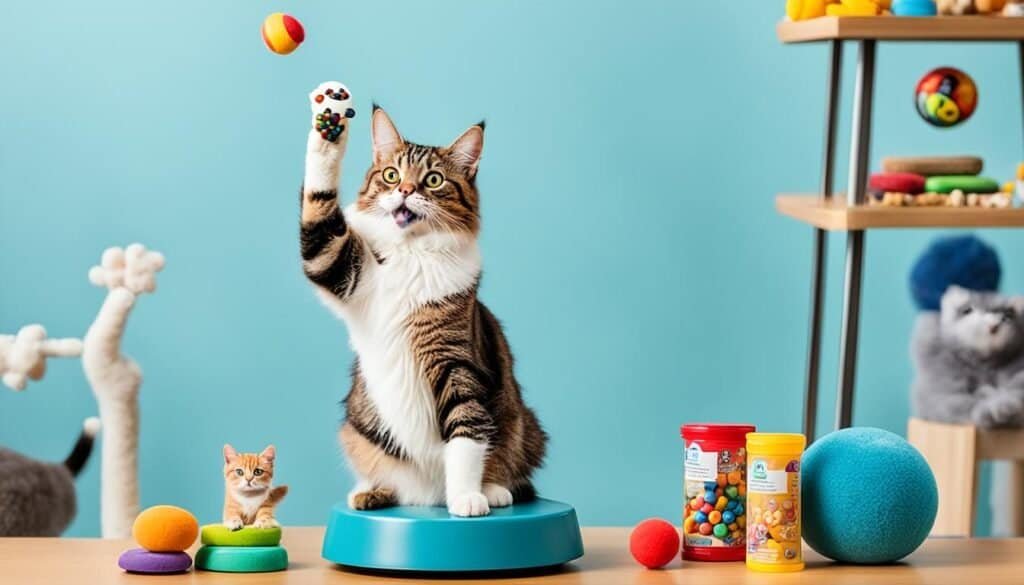
4. Target Discrimination
Target discrimination involves teaching your cat to differentiate between different targets and respond to each one differently. For example, you can train your cat to touch a red target with their paw and a blue target with their nose. This advanced technique enhances your cat’s cognitive abilities and their ability to follow specific cues.
5. Chains and Sequences
Chains and sequences are created by linking multiple behaviors together. By teaching your cat a series of behaviors, you can create impressive routines or performances. For instance, you can train your cat to jump on a stool, walk across a balance beam, and then spin in a circle. Break the chain into smaller steps and use the clicker to mark and reward each behavior. Gradually increase the number of behaviors in the chain for a captivating display of your cat’s skills.
Remember, advanced clicker training techniques require consistency, patience, and positive reinforcement. Keep training sessions short to ensure your cat remains engaged and interested. With practice and dedication, you and your cat can accomplish remarkable feats through clicker training.
Conclusion
Clicker training is a powerful and effective method for training your cat. By following the techniques and tips provided in this article, you’ll be well-equipped to embark on a successful clicker training journey with your feline friend.
Throughout the article, we’ve explored the basics of cat clicker training, highlighted the importance of positive reinforcement, and shared advanced techniques to challenge and engage your cat. By using a clicker as a communication tool, you can establish a strong bond and foster a deeper understanding with your furry companion.
Not only does clicker training enable you to teach your cat new behaviors and address undesirable habits, but it also promotes mental stimulation, provides an outlet for their natural instincts, and strengthens the human-animal bond. With patience and consistency, your cat will develop new skills and showcase their intelligence and willingness to learn.
Remember that clicker training is a journey, and each cat is unique. Celebrate small victories along the way and adapt the techniques to suit your cat’s personality and learning style. By implementing the strategies discussed in this article, you can create a positive training environment and achieve remarkable results in your cat’s behavior and obedience.
FAQ
What is Cat Clicker Training?
How does Cat Clicker Training work?
What is the best clicker for cat training?
How do I train my cat with a clicker?
What are some clicker training tips for cats?
How can clicker training help with cat behavior?
What clicker training tools are available for cats?
Why is positive reinforcement important in cat training?
What are some advanced clicker training techniques for cats?
Last modified: March 11, 2024

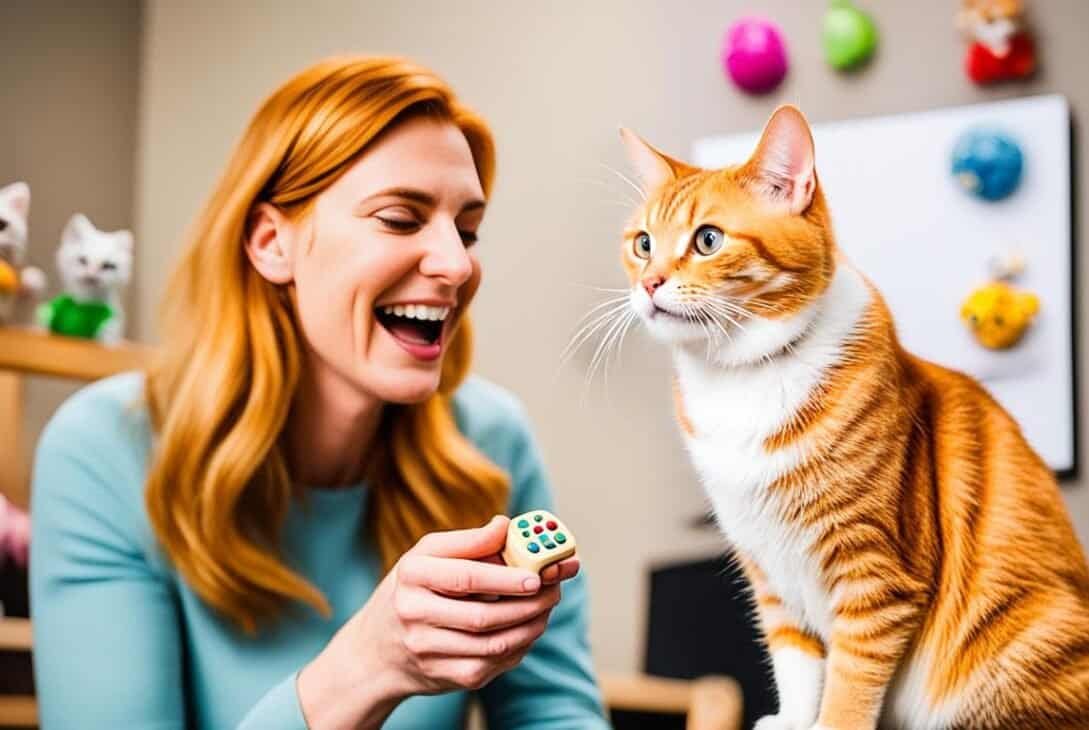

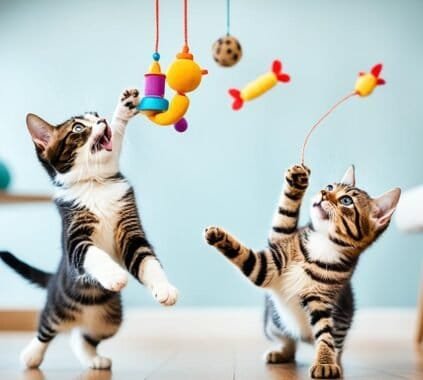

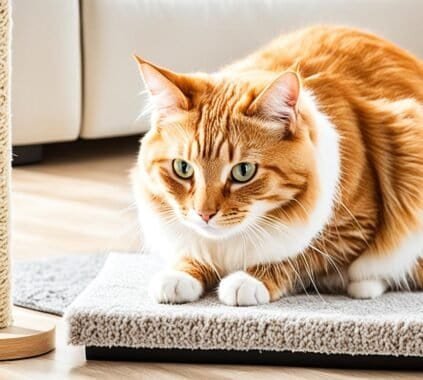








[…] Training your cat to use the litter box reduces the risk of indoor accidents and promotes good litter box habits. […]